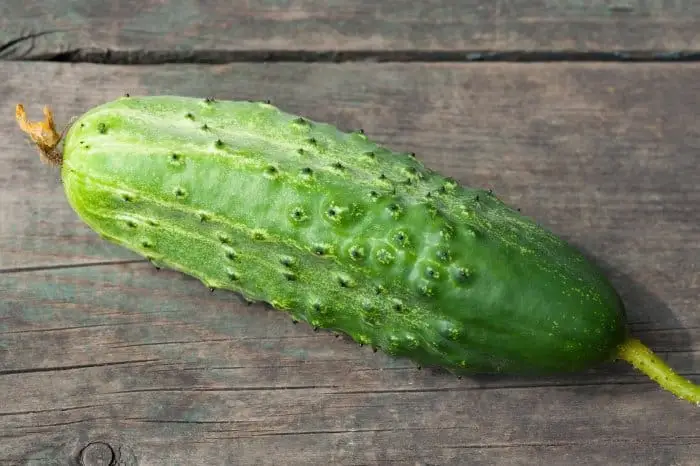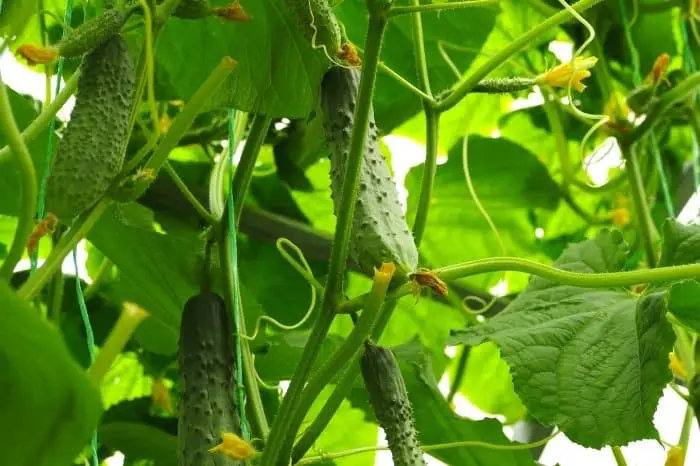Last Updated on October 28, 2022
Why are my cucumbers prickly and hurting my hands during harvesting instead of their skin being as smooth as those from the grocery store?
Are you growing cucumbers only to notice that your vines are loaded with prickly skinned fruits? Most gardeners get confused especially if they have never seen this type of cucumbers before.
Prickly cucumbers mean there are spikes on cucumbers and are as common as thorny cactus but less dangerous. To learn why there is prickly cucumber, keep reading this article.
Why Are My Cucumbers Prickly?
Cucumbers are members of the cucurbit family, together with pumpkins, squash, and melons. They are divided into 2 groups pickling and slicing varieties.
Both varieties may have different degrees of their spikiness. This means that prickly cucumbers are quite normal to find among gardeners. Some cucumbers have tiny little hairs, while others are genuinely spiky cucumbers.
The slicing varieties are usually less prickly, and the pickling has more spines. So if you have noticed your cucumbers are more prickly than usual, rest assured that they are suitable for consumption as they are just naturally like that.

Can You Eat Prickly Cucumbers?
Spikes on cucumbers are not deadly; however, they are terribly uncomfortable to eat. The good news is that you can feel your cucumber if they have too many pickles on them before consumption.
You will find that most prickly cucumber fruits are covered with minor spikes that quickly come off, given a good washing. If they won’t come off right away, use a veggie brush to brush them off while cleaning them.
A soft brush that does not bruise the cucumbers should be enough to remove the prickly skin. Today most varieties grown have been bred to be spineless; the more reason the cucumbers sold in the supermarkets have no spines.
Why Are My Cucumbers Prickly An Inherited Trait
All cucumbers have different features, including the size of prickles. The same way they inherit shape, size, color, and flavor, every cucumber variety inherits its prickles as well. This is mother nature’s way of protecting these plants from insects or animals that would destroy them.
Many modern cucumbers are grown for pickling with almost no spikes. However, most pickling cucumbers are naturally covered with white or black spikes.
How To Handle Prickly Cucumbers
If your cucumbers are prickly, ensure that you handle them carefully to avoid getting your hands hurt. Use a pair of gardening gloves that stays on until you have safely transported your cucumbers to the kitchen.
Wear your plastic kitchen gloves when washing them to avoid getting hurt in the process. If your cucumbers are normal prickly like the kiwi fruit, you can handle them with bare hands.
COOLJOB Gardening Gloves for Women, 6 Pairs Breathable Rubber Coated Garden Gloves
Scrapping Prickly Cucumbers
Scrapping the prickles from cucumbers under running water requires that you wear your plastic cleaning gloves to protect your bare hands from getting pricked. Use a soft brush to gently clean their skin and remove the spikes that could be a bit stubborn.
You can also wrap them in a kitchen towel and rub vigorously to remove the spikes. Remember to empty the towels’ content directly into your disposal or trash can to keep them away from your household.
Sometimes even the store-bought cucumbers all go through this method to remove the spikes followed by a wax job before displaying them on the shelves looking pretty.
Check Out What Is Eating My Broccoli Leaves?
How To Harvest Prickly Cucumbers
Suppose you are harvesting your cucumbers that are prickly harvest them when they are about 2 inches long. If you plan to make dill pickles, you can harvest them when they are at least 3 or 4 inches long.
For slicing cucumbers, harvest them when they are at least 7 to 9 inches long and have a darker green color. If they grow larger than this, there will be more bitter and have an unpleasant texture.
When you harvest your cucumbers, leave at least one section of stem attached to the cucumber. This prevents the stem from rotting when storing them, especially if you are not using your cucumbers right away. The easiest way to do this is to cut the cucumber off the vine using a sharp knife or a pair of scissors. If you twist or pull the cucumber off the vine, you will damage your plant.
Be sure to wear gloves when harvesting prickly cucumbers. If your cucumbers have a lot of spines, remove them by rubbing a cloth or a soft vegetable brush along the length of the fruit.

The smooth varieties of cucumbers are susceptible to bruising during harvesting. Ensure that you lay them gently in a container as you harvest them to avoid bruising of the skin.
Learn more about How Deep Do Cucumber Roots Grow?
Smooth-skinned Cucumbers
If you would prefer to grow smooth-skinned cucumbers instead of those with numerous pricks on them, you can choose to grow the following cultivars.
- Tsuyataro. This is a mildew-resistant cultivar that is a best seller in Japan. Start harvesting your backless cucumbers when they’re 8 inches for slicing. From seed to maturity, they take about 57 days.
- La diva. This variety is a 6-foot vine that yields loads of cigar-sized cucumbers. The produce is reading from mid-summer into mid-fall. This variety has juicy, crisp, and great cucumbers for pickling or slicing.
- Amiga. This flavorful deep green cucumber is ready for picking in 55 days from planting. This variety is resistant to cucumber mosaic virus, papaya ringspot virus, and powdery mildew.
Growing Conditions For Cucumber
Cucumbers thrive in full sun and well-drained soil. It requires the amendment of organic compost manure.
Start your seeds indoors or wait until the temperatures outdoors have warmed to at least 60 degrees Fahrenheit to plant them directly in the soil. Ensure that the danger of frost has passed before planting them outdoors.
Cucumbers prefer warmer temperatures of about 70 degrees Fahrenheit during the day and 60° Fahrenheit at night.
If you start your seeds indoors, do so at least two to three weeks before the last frost date in your area. Use the soilless potting mix to give you good germination results. Before transplanting your seedlings outside, be sure to harden them off to minimize transplanting shock.
When planting in your garden space, your slicing cucumbers are at least 12 24 inches apart in rows 5 to 6 feet apart. Space them at least 8 to 12 inches apart in rows of 3 to 6 ft apart for pickling cucumbers.
If you choose to directly so your seeds outdoors, place at least two to three seeds per hill and thin out the weakest once they germinate.
Water your cucumber plants deeply and regularly and fertilize them if possible. If you have added your compost manure when planting, you will not need to fertilize them as they will have plenty of nutrients.
If you are growing a vining variety, be sure to provide some support before it produces fruits.
FAQs
How do you get rid of cucumber spikes?
Cucumbers, like many other vegetables, have a tendency to develop "spikes" that appear in the middle of the vegetable.
You can use your fingers to remove the spikes. I also used to use a plastic spatula. It's better to do this when they are young and small though.
What causes pointy cucumbers?
Cucumbers are a part of the nightshade family, and they belong to the gourd family. They are an annual plant that can grow up to five feet tall and produces white flowers. Cucumbers are an easy plant to grow, but there are a few things that you need to know about them before you purchase your seeds or plants.
It turns out that cucumbers with this shape can be caused by a number of different factors, from being left out in the sun too long to simply being in the wrong spot when they were planted.
Can you pick a cucumber too early?
The answer is yes, but it depends on the variety. Cucumbers are easy to grow, and you can start them indoors in pots or seed trays for transplanting outdoors in late spring or early summer. They're a great addition to any garden because they have a long season of production. Most varieties have a short shelf life, however, and will only last a few days after picking.
How often should I water my cucumbers?
Cucumbers have a high water content, so they should be watered regularly. Cucumber plants need to be watered at least once a week to grow well and produce large fruit.
Why are my cucumber skins tough?
Cucumbers are notorious for having rough and tough skin, especially during the first few weeks of growth. The skin toughens as the fruit ripens and the fruit develops a seed coat. However, there is no way to know how much of the skin is due to the ripening process and how much is due to a rough-skinned seedling.
Sometimes, itt's the soil.
Can you overwater a cucumber plant?
Yes, you can. If you're worried about them drying out, you can cover the soil around the plants with plastic wrap and/or place them in a warm spot. It is possible that you can grow them indoors without any problems, but they will not produce as well.
Conclusion
Most gardeners are enthusiasts of growing cucumber. Almost everyone can plant either the prickly or smooth-skinned cucumber.
Now that you know why your cucumbers are prickly, the main thing to know is simply the basic requirements of growing this crop whether prickly or smooth the main reason for their skin formation is to protect them from predators.

Lory is an avid gardener who loves spending time outdoors. She is passionate about using her green thumb to create beautiful, lush gardens for her friends and family. She finds joy in tending to her garden, trimming plants, and cultivating new species. She loves to share her knowledge and experience with others who have a similar enthusiasm for gardening. Lory is a true nature enthusiast who loves to share her enthusiasm for the outdoors with all who meet her.

